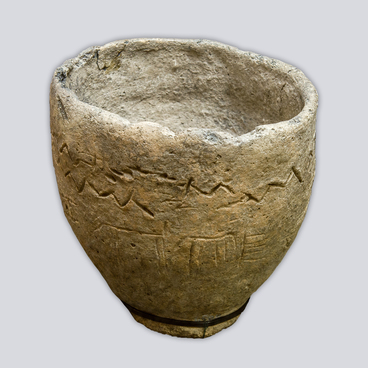In 1960 and 1961, archaeologists found a few surviving plates dated the 8th -7th centuries BC at the bottom of the Kuibyshev water reservoir. Those were burial stelai of the Ananyino culture, which existed in the mid-stream Volga region and the Kama river basin in the 9th -3rd centuries BC.
Burial stele of the Ananyino culture
Creation period
8th-7th century BC
Dimensions
100x38x18 cm
100х38х18 cm
100х38х18 cm
Technique
limestone, chiselling
Exhibition
1
Open in app#1
Burial stele of the Ananyino culture
#4
#5
Experts believe that the tradition to install such plates arrived in the Volga-Kama region from Central Asia. Ananyino people would erect them in between graves, not above them. Rows of such plates would serve as a kind of fence separating graves, the central part of the necropolis, and the sacrifice zone, which was deemed sacral and designed for various ceremonies.
The theory is that such monuments could be installed in family cemeteries, abandoned villages, and other places associated with the deceased. Ananyino and Ugric tribes believed such stelai to become receptacles for dead people’s spirits, in particular the spirits of people who showed heroism during their lifetime.
#6
The one metre tall stele on display is made of limestone. It has wedge-like depressions carved in the top and bottom parts, while the middle part shows an axe and a dagger with oppositely directed handles.
#7
Scholars call such statues pseudoanthropomorphic. They symbolize a human figure without depicting it in detail. However, the weapon in the stele is chiselled in the manner in which it would be worn in ancient times: the axe is stuck in the statue’s belt, and the knife is in the sheath.
Statues of this kind were not indicative of the deceased person’s sex, unlike burial decoration articles. For instance, men’s graves contain labour implements and weapons: spears, swords, daggers, and arrowheads while women’s burial accessories include bracelets, sets of plaques, and other metal decorations. Food would also be traditionally put in graves: beef for women and horsemeat for men.
Statues of this kind were not indicative of the deceased person’s sex, unlike burial decoration articles. For instance, men’s graves contain labour implements and weapons: spears, swords, daggers, and arrowheads while women’s burial accessories include bracelets, sets of plaques, and other metal decorations. Food would also be traditionally put in graves: beef for women and horsemeat for men.
#2
Horses generally played a special role in burial rites of Ananyino tribes. Archaeologists have often found horse harnesses and accessories in graves and horse teeth and bones nearby.
#8
National Museum of the Republic of Tatarstan
read morehide
00:00
00:00
1x
Burial stele of the Ananyino culture
Creation period
8th-7th century BC
Dimensions
100x38x18 cm
100х38х18 cm
100х38х18 cm
Technique
limestone, chiselling
Exhibition
1
Open in app
Share


